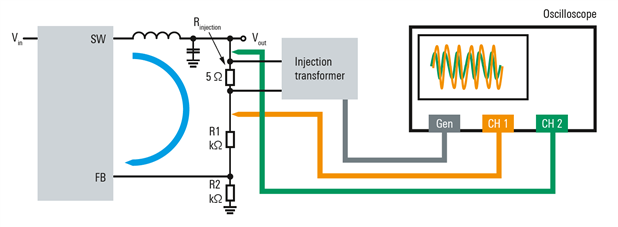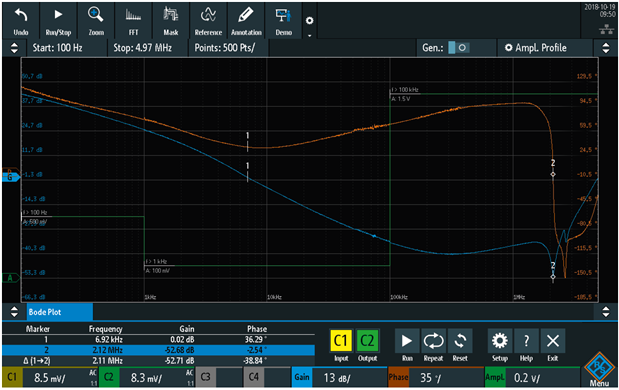A well compensating voltage controller enables stable output voltages and reduces the influence of load changes and supply voltage variations.
Why are control loop response measurements important?
The quality of a control circuit determines the stability and dynamic response of the entire DC/DC converter. The control loop behavior must be measured and characterized to ensure the stability of voltage regulators and switched mode power supplies. The R&SRTx-K36 frequency response analysis, respectively the Bode plot option allows you to quickly determine the gain and phase margin of switched-mode power supplies or linear regulators. These measurements help determine the control loop stability.
Oscilloscopes as a tool for control loop response measurements
When testing and characterizing their power supply designs, engineers mainly rely on oscilloscopes. The R&SRTx-K36 frequency response analysis option provides a low-cost alternative to low frequency network analyzers or dedicated standalone frequency analyzers. The option allows for easy and quick analysis of low frequency response on the oscilloscope. Using the option, users can characterize the frequency response of a variety of electronics, including passive filters and amplifier circuits. The R&S
RTx-K36 frequency response analysis option uses the oscilloscope’s built-in waveform generator to create stimulus signals ranging in frequency from 10 Hz to 25 MHz. Measuring the ratio of the DUT signal input and output at each test frequency, the oscilloscope plots gain logarithmically and phase linearly.
How can control loop response be measured?
Control loop response testing requires injecting an error signal over a band of frequencies into the feedback path of the control loop. To inject the error signal, a small resistor must be inserted into the feedback loop.
The 5 Ω injection resistor (shown in the figure below) is insignificant in comparison to the series impedance of R1 and R2. Some users choose to permanently design in this low-value injection resistor (Rinjection) for test purposes. An injection transformer, such as Picotest’s J2100A, isolates the AC distortion signal and eliminates any DC bias.
Why is it important to choose the correct injection point?
To measure the loop gain of a voltage feedback loop, the loop needs to be broken at a suitable point. A distortion signal is injected at this point and distributed in the loop circuit. Depending on the loop gain, the injected distortion signal will be amplified or attenuated and shifted in phase. For the R&SRTx-K36 option, the generator of the oscilloscope generates the distortion signal and the oscilloscope measures the transfer function of the loop. To ensure that the measured loop gain equals the real loop gain, a suitable point needs to be chosen.
Accurate control loop response characterization depends on good probing. Peak-to-peak amplitudes of both Vin and Vout can be very low at some test frequencies. These values would be buried either in the oscilloscope’s noise floor and/or in the switching noise of the DUT itself. This is why increasing the SNR of your measurements will significantly improve the dynamic range of your frequency response measurements. Ideally, you should use a low noise 1:1 passive probe that will reduce measurement noise and improve SNR of your measurement.
What do you get?
The curves displayed in the Bode plots represent the transmission function of your circuit and help verify the stability of your system. One graph (blue trace in screenshot) displays the amplitude behavior over the frequency range in dB, while the second plot (orange trace in screenshot) displays the phase characteristics over frequency (measured in degrees).


